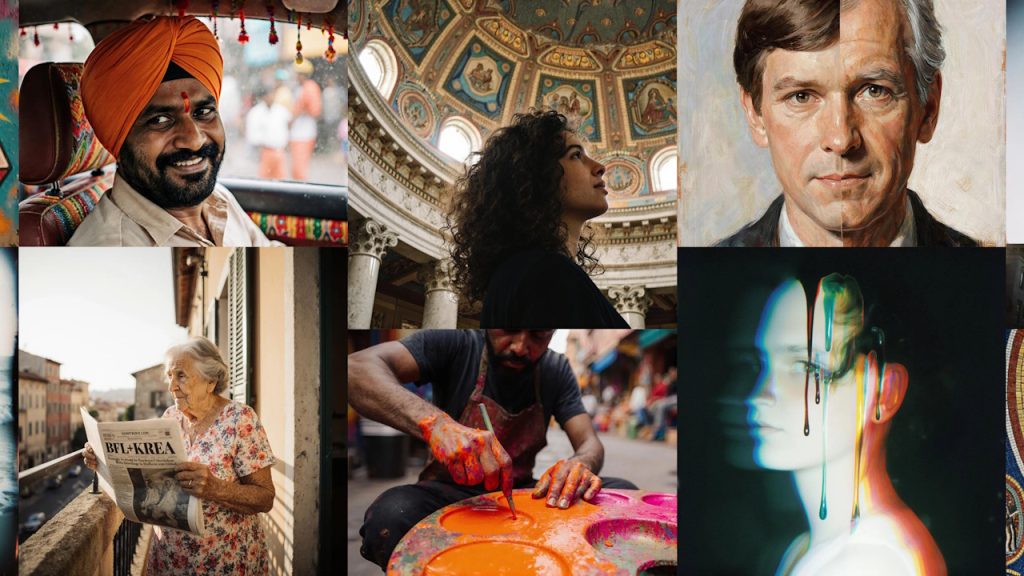Black Forest Labs and Alibaba are challenging AI incumbents with specialized image models. On July 31, BFL and Krea AI released FLUX.1 Krea, targeting photorealism to avoid the generic “AI look.” Today, Alibaba’s Qwen team launched Qwen-Image, a model excelling at complex text rendering.
Both open-weight models are available online for developers. Their releases signal a strategic shift in the generative AI market, where niche capabilities are being prioritized to solve specific creative problems and challenge the dominance of general-purpose tools.
FLUX.1 Krea: Aims for Photorealism Over AI Saturation
Black Forest Labs (BFL), in a strategic partnership with Krea AI, is directly targeting a common criticism of AI art: its tendency toward oversaturated, artificial-looking textures. Their new 12-billion parameter model, FLUX.1 Krea, is described as an “opinionated” tool designed specifically to achieve a more distinctive and authentic photorealism, moving beyond the hyper-stylized outputs that have become synonymous with the technology.
The goal, according to BFL’s announcement, is to provide a tool that offers “pleasant surprises in the form of diverse, visually interesting images.” The company claims the model’s performance is on par with closed-source alternatives in human preference assessments and that it was trained using guidance distillation, a technique that makes it more efficient to run.
Crucially, the model is built on the existing FLUX.1 architecture, making it a drop-in replacement for developers already working within that ecosystem. This architectural compatibility is key to fostering rapid adoption and customization, building on the foundation of BFL’s earlier FLUX.1 Kontext release. Developers are encouraged to use the provided GitHub repository as a starting point for integration.
BFL is employing a dual-license strategy common in the open-source AI space. The model’s weights are available on Hugging Face under a non-commercial license for research, artistic, and personal use. For commercial applications, licenses are available through the BFL Licensing Portal, with API access offered by partners including FAL, Replicate, Runware, DataCrunch, and TogetherAI.
Underscoring the industry’s focus on safety, the model’s release is accompanied by a detailed list of risk mitigations. BFL notes that it filtered pre-training data for NSFW content and partnered with the Internet Watch Foundation to remove known child sexual abuse material. The license explicitly prohibits using the model for illegal purposes or generating harmful content, and the company states it may verify that deployers are using the provided safety filters.
Qwen-Image: Tackling AI’s Persistent Text Problem
Just days after BFL’s release, Alibaba’s Qwen team addressed another long-standing weakness in AI image generation: text rendering. The team released Qwen-Image, a powerful 20-billion parameter model engineered to create images with high-fidelity, legible text.
This is a significant technical hurdle. Most diffusion models struggle to form coherent letters and words, often producing garbled or nonsensical characters. Qwen-Image, however, can accurately render complex, multi-line text in both English and Chinese, as shown in its examples.
The model’s capabilities extend to creating detailed posters, infographics, and even presentation slides directly from text prompts. This positions it as a powerful tool for professional content creation, a domain where accuracy is paramount.
The release under a permissive Apache 2.0 license encourages broad adoption and commercial use, a key part of Alibaba’s strategy. This follows the launch of its more general Qwen VLo model in June, indicating a pattern of building foundational models before releasing specialized variants.
Open Models Enter a Crowded and Contentious Market
These specialized models are not being released into a vacuum. They enter a fiercely competitive arena where major tech companies are rapidly advancing their own platforms. Google launched its Imagen 4 model in June, also claiming “significantly improved text rendering” as a key improvement.
Established players are also adapting their strategies. In April, Adobe overhauled its Firefly platform to incorporate third-party models, including earlier BFL technology. This signals a potential industry shift toward integrated creative hubs rather than single-model ecosystems.
The competition is also expanding beyond still images. Midjourney recently launched its first AI video tool. This relentless pace of innovation puts constant pressure on all developers to differentiate.
Alibaba itself is rapidly integrating these technologies into its consumer products. Its Quark AI assistant is “evolving into a gateway for users to explore everything AI can offer,” according to CEO Wu Jia, transforming it into a hub for AI services. This vertical integration is a key part of its competitive strategy.
However, this innovation occurs under the shadow of significant legal and geopolitical pressures. The entire AI industry is grappling with copyright disputes. A landmark lawsuit filed by Disney and Universal against Midjourney questions the legality of training models on copyrighted content.
The case is a focal point in a wider conflict over data scraping. As Disney’s general counsel bluntly stated, “piracy is piracy, and the fact that it’s done by an A.I. company does not make it any less infringing.” This legal uncertainty creates immense risk for developers and enterprise customers alike, making data provenance a critical issue.
For a company like Alibaba, these challenges are compounded by geopolitical friction. The tech rivalry between the U.S. and China creates hurdles for international collaboration. As one analyst from the Center for Strategic and International Studies noted, “the United States is in an AI race with China, and we just don’t want American companies helping Chinese companies run faster.”
This complex environment means success depends not just on technical skill, but on navigating a treacherous legal and political landscape. By open-sourcing powerful models, both BFL and Alibaba aim to build global developer communities as a strategic advantage to counter these pressures.
Ultimately, the releases of FLUX.1 Krea and Qwen-Image highlight a maturing market. While large, general-purpose models still dominate, there is a growing demand for specialized tools that excel at specific tasks. This new front in the AI race is less about scale and more about precision.

